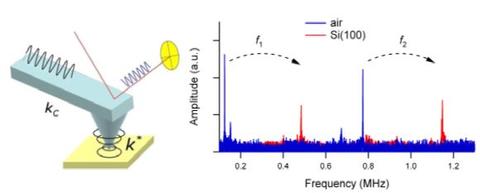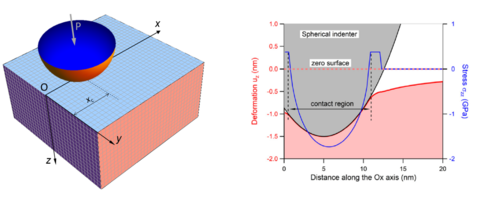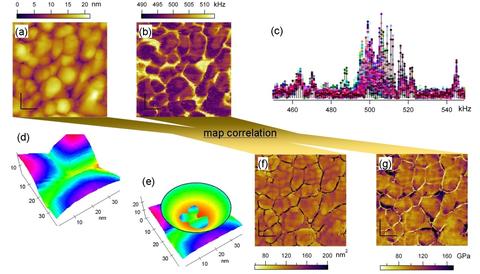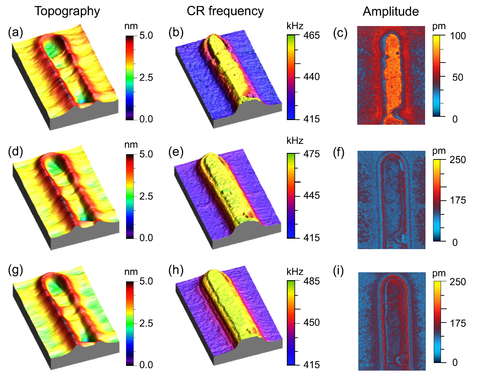Contact Resonance Atomic Force Microscopy (CR-AFM)
Summary
Contact Resonance AFM (CR-AFM) is one of the most reliable and accurate AFM methods for nanoscale elastic/viscoelastic property measurements. In terms of elastic modulus measurement CR-AFM has a large range from few GPa to hundreds of GPa. Over the years we have continuously improved the quantitative CR-AFM measurements in terms of instrument developments, elastic modulus calibration, contact mechanics analysis, and applications on a variety of materials and structures, including but not limited to elastic properties of one-dimensional structures (nanowires, nanotubes, fibers), thin film coatings, layered materials, organosilicate patterns, nanocomposites, etc. Paired with the built-in nanoscale positioning of the AFM, the integrative CR-AFM measurements provide a unique mechanical characterization for the next generation of materials and structures used in nanoscale applications and devices.
Description
In CR-AFM the local elasticity of a surface is probed by observing the shift in one of the eigenmode resonance frequencies of an AFM probe brought into contact with the surface. The resonance frequencies of the AFM cantilever change in accordance to the elastic stiffness of the probe-sample contact.

Based on the cantilever dynamics, the measured CR frequencies are converted into contact stiffnesses, which further are used to determine the elastic modulus of the sample tested by applying an appropriate contact mechanics description to the tip-sample contact. This poses a few challenges in terms of unavailable geometrical parameters (e.g. tip shape, contact radius), different surface mechanics across materials (e.g. adhesion, viscoelasticity), and lack of analytical contact mechanics models for various sample geometries. The analysis of the contact mechanics is done either by an analytical model or numerical calculations in the absence of an analytical solution. Also, the accuracy of CR-AFM measurements is greatly enhanced by using reference materials, with successive measurements on the test material and reference materials of known elastic moduli; this procedure can circumvent some parameters that are not available for measurement.

CR-AFM has the spatial resolution on the order of several nanometers (limited by the contact radius of the probing tip) and a measurement uncertainty of about ± 5 % for elastic moduli in the range of a few GPa to hundreds of GPa. With the AFM versatility of probing substrate-supported nanostructures, CR-AFM can be used for the elastic modulus measurements of various one-dimensional nanostructures (nanowires, nanotubes), two-dimensional systems (atomic layers, thin coatings), as well as three-dimensional architectures (patterns, composites). CR-AFM requires no additional testing device or specimen manipulation and it was implemented in various forms on most of the AFM platforms.
Major Accomplishments
CR-AFM calibration on multiple reference materials. When some of the geometrical parameters like tip radius or cantilever stiffness are not readily available in CR-AFM measurements, the alternative is to perform CR-AFM tests on some reference materials in addition to that on the test sample. By taking the ratio of the contact stiffnesses measured on test and reference materials, the unknown parameters are eliminated (under the assumption that the contact geometry is preserved during measurements) and the elastic modulus of the test sample is quantitatively determined. The uncertainty of the measurements is greatly reduced when two reference materials with elastic moduli bracketing that of the test material are used for CR-AFM calibration.

CR-AFM on one-dimensional nanostructures. CR-AFM was successfully applied to measure the elastic moduli of various nanowires and nanotubes. Detailed modeling, both analytical and numerical, were used either to assess the surface effects on the core-shell composition of some nanowires or just determine the elastic moduli of one-dimensional nanostructures with unconventional geometries. Unlike most of the currently developed nanoscale mechanical tests for one-dimensional nanostructures (e.g. tensile tests observed inside a scanning electron microscope), CR-AFM requires no additional testing device or manipulation but simply substrate-supported specimens.

CR-AFM mapping on granular surfaces. By performing CR-AFM measurements during an AFM topographical scanning, a map of the elastic modulus can be retrieved from the measured CR frequencies and be associated to the scanned surface. The conversion from the measured CR frequencies to elastic moduli preserves the CR contrast on flat regions within the scanned surface. However, variations in the contact geometry during scanning must be accounted for on surfaces with significant roughness, granularity, sharp edges, or any other non-flat geometries for correct elastic modulus determination.

Load-dependent CR-AFM on Cu/low-k dielectric circuits. Better description of the tip-sample contact mechanics is obtained in load-dependent CR-AFM measurements, namely when same material is tested under a series of different loads. Such measurements help in narrowing down the contact mechanics model that needs to be used and reduce the uncertainty of the determined elastic moduli.

Relevant Publications
- Calibration of CR-AFM by reference materials: Review of Scientific Instruments 77, 103707 (2006); https://doi.org/10.1063/1.2360971
- Elastic moduli of nanowires by CR-AFM: Nano Letters 7, 3691 (2007); https://pubs.acs.org/doi/10.1021/nl071986e
- Elastic moduli of nanowires by CR-AFM: Applied Physics Letters 92, 241908 (2008); https://doi.org/10.1063/1.2945285
- CR-AFM for nanoscale elastic modulus measurements: Ultramicroscopy 109, 929 (2009); https://doi.org/10.1016/j.ultramic.2009.03.025
- CR-AFM mapping on granular surfaces: Nanotechnology 19, 235701 (2008); https://doi.org/10.1088/0957-4484/19/23/235701
- Elastic modulus of nanotubes by CR-AFM: Nanotechnology 20, 035706 (2009); https://doi.org/10.1088/0957-4484/20/3/035706
- Elastic moduli of low-k dielectric films by CR-AFM: Journal of Materials Research 24, 2960 (2009); https://doi.org/10.1557/jmr.2009.0357
- Stress effect on elastic moduli of nanowires by CR-AFM: Nano Letters 10, 2031 (2010); https://pubs.acs.org/doi/10.1021/nl100062n
- Mechanical properties of one-dimensional nanostructures by CR-AFM: Scanning Probe Microscopy in Nanoscience and Nanotechnology pp 571-611, 2010; https://doi.org/10.1007/978-3-642-03535-7_16
- CR-AFM mapping of Cu/low-k dielectric circuits: Nanotechnology 23, 215703 (2012); https://doi.org/10.1088/0957-4484/23/21/215703
- Elastic moduli of low-k dielectric films: Proc. SPIE 8466, 84660A (2012); https://spie.org/Publications/Proceedings/Paper/10.1117/12.930482?SSO=1
- Bending strength of nanowires by AFM: Nano Letters 12, 2599 (2012); https://pubs.acs.org/doi/abs/10.1021/nl300957a
- Bending and fracture of nanowires by AFM: Journal of Materials Research 27, 562 (2012); https://doi.org/10.1557/jmr.2011.354
- Structure-property relationship of low-k dielectric films: Journal of non-crystalline solids 379, 67 (2013); https://doi.org/10.1016/j.jnoncrysol.2013.07.028
- Elastic moduli of porous low-k dielectric films by CR-AFM: Applied Physics Letters 105, 152906 (2014); https://aip.scitation.org/doi/10.1063/1.4898351
- Frequency, amplitude, and phase of CR-AFM: Beilstein Journal of Nanotechnology 5, 278 (2014); https://www.beilstein-journals.org/bjnano/articles/5/30
- Buckling of organosilicate fins during patterning: Nano Letters 15, 3845 (2015); https://doi.org/10.1021/acs.nanolett.5b00685
- Adhesive contacts on a half-space: International Journal of Solids and Structures 87, 1 (2016); https://doi.org/10.1016/j.ijsolstr.2016.02.043
- Nanoparticle size-measurement by AFM: International Journal of Medicine 11, 1567 (2016); https://doi.org/10.2147/IJN.S101463
- Nanoparticle size-measurement by AFM: PLOS one 12, e0189273 (2017); https://doi.org/10.1371/journal.pone.0189273
- Nanoparticle size-measurement by AFM: Soft Matter 14, 1311 (2018); https://doi.org/10.1039/C7SM01971H
- Elastic moduli of entropy-stabilized oxides: Advanced Materials 30, 1805004 (2018); https://doi.org/10.1002/adma.201805004
- Adhesive contacts on the edge of a quarter-space: International Journal of Solids and Structures 158, 165 (2019); https://doi.org/10.1016/j.ijsolstr.2018.09.006
- Review on AFM mechanical property measurements: Journal of Vacuum Science & Technology B 38, 060801 (2020); https://doi.org/10.1116/6.0000544
- CR-AFM depth sensitivity: ACS Appl. Mater. Interfaces 14, 55238−55248, (2022); https://pubs.acs.org/doi/full/10.1021/acsami.2c17962
Impact and customers
- Develop instrumentation, measurement protocols, and calibration procedures for various AFM-based nanomechanical property measurements. Promote CR-AFM methodology for readily integration into existing AFM platforms.
- Perform state-of-the-art quantitative nanoscale mechanical property measurements on samples and devices from various academic institutions, government laboratories, and industries.
- Collaborations with and knowledge dissemination to AFM developers on nanoscale mechanical property measurements and analysis.
Contacts
-
(301) 975-3675

